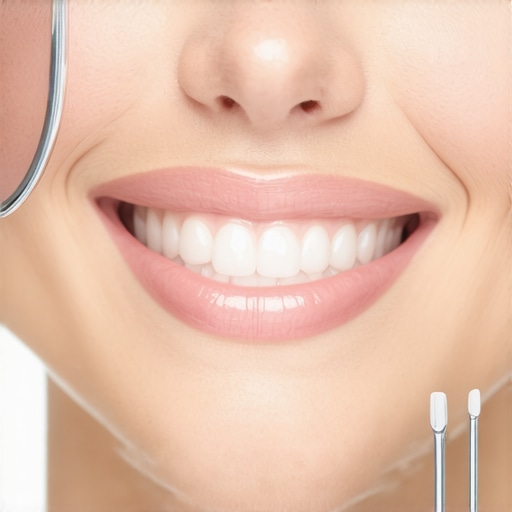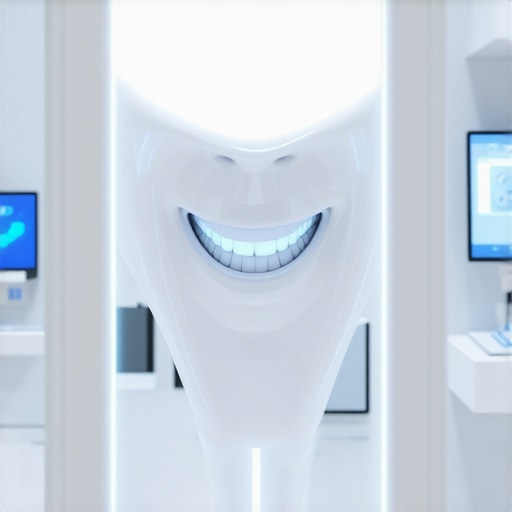Unlocking the Synergy Between Invisalign and Teeth Whitening: An Advanced Perspective on Smile Makeovers
In the rapidly evolving landscape of cosmetic dentistry, the confluence of Invisalign orthodontics and professional teeth whitening techniques epitomizes a sophisticated approach to achieving optimal smile aesthetics. As an expert in dental innovations, I recognize that integrating these modalities not only enhances aesthetic outcomes but also reflects a nuanced understanding of oral health dynamics and material interactions.
The Scientific Foundations of Combined Orthodontic and Whitening Procedures
At the core of effective smile transformation lies a meticulous comprehension of enamel biology, stain removal mechanics, and orthodontic biomechanics. Invisalign’s clear aligners exert controlled force vectors, enabling precise tooth movement without compromising enamel integrity. Concurrently, whitening agents—typically hydrogen peroxide-based—must be employed judiciously to avoid adverse interactions with orthodontic materials or enamel surfaces, as supported by recent clinical studies published in the Journal of Esthetic and Restorative Dentistry.
Strategic Sequencing and Customization in Smile Makeover Protocols
Expert-level treatment planning advocates for a staged approach: initial orthodontic realignment to correct malocclusions and crowding, followed by targeted whitening sessions. This sequencing ensures that extrinsic stains are effectively addressed and that subsequent enamel polishing can be optimized for aesthetic harmony. Advanced digital smile design tools facilitate this process, allowing clinicians to simulate outcomes and tailor interventions precisely.
Addressing Complex Patient Queries: Is Combined Invisalign and Whitening Safe for Enamel Health?
This question encapsulates a prevalent concern among dental professionals and patients alike. The safety profile hinges on meticulous material compatibility assessments and adherence to evidence-based protocols. When properly managed, Invisalign’s plastic materials do not impede whitening efficacy, and professional-grade whitening treatments are designed to preserve enamel integrity. However, overuse or improper timing can lead to transient sensitivity or enamel demineralization, emphasizing the importance of expert supervision.
Enhancing Results with Ancillary Cosmetic Procedures
Beyond aligners and whitening, options such as porcelain veneers or composite bonding can further refine smile aesthetics, especially in cases of structural imperfections or intrinsic discoloration. For comprehensive insights into aesthetic enhancements, visit this authoritative resource.
Engage with Proven Expertise and Contribute to the Field
For clinicians seeking to elevate their practice, continuous education in cutting-edge cosmetic techniques remains crucial. Sharing case studies and outcomes enhances collective knowledge and fosters innovation. Interested practitioners are encouraged to explore our detailed guide on latest Invisalign advancements.
In conclusion, the integration of Invisalign and teeth whitening embodies a sophisticated synergy that, when executed with clinical precision, results in harmonious, radiant smiles. As the field advances, staying informed about material science, procedural sequencing, and emerging technologies will enable practitioners to deliver unparalleled aesthetic outcomes.
Revolutionizing Smile Aesthetics: The Role of Digital Smile Design in Modern Dentistry
Digital Smile Design (DSD) has emerged as a transformative tool in the realm of cosmetic dentistry, enabling practitioners to craft highly personalized, predictable, and aesthetically pleasing smile makeovers. By leveraging 3D imaging and simulation software, clinicians can visualize potential outcomes, ensuring alignment with patient expectations and functional harmony. Integrating DSD with Invisalign treatments and whitening procedures not only streamlines the treatment process but also enhances patient satisfaction by setting clear, achievable goals.
How Do Material Interactions Influence the Longevity of Combined Cosmetic Procedures?
Understanding the interactions between whitening agents, aligner materials, and restorative composites is crucial for durable results. Recent research indicates that hydrogen peroxide-based whitening products can temporarily weaken the enamel surface, which may increase susceptibility to staining or minor damage if not properly managed. Similarly, aligner plastics are formulated to resist staining and maintain transparency, but improper cleaning or prolonged exposure to certain agents can compromise their clarity. Expert protocols emphasize the importance of sequencing treatments appropriately and selecting compatible materials to maximize longevity and aesthetic stability, as highlighted in the Journal of Esthetic and Restorative Dentistry.
From an Expert Perspective: What Are the Nuances of Achieving Natural-Looking Results with Combined Cosmetic Procedures?
This is a pivotal question that often challenges even seasoned practitioners. Achieving natural aesthetics involves meticulous attention to tooth color gradation, translucency, and proportion. Advanced digital tools allow us to simulate these nuances before treatment begins, tailoring whitening shades to complement the patient’s skin tone and facial features. Additionally, minimally invasive procedures like veneers and bonding can be customized to blend seamlessly with natural dentition. The key lies in a comprehensive, patient-centered approach that considers individual variations and employs evidence-based techniques for optimal harmony.
For those looking to refine their practice, ongoing education and case study reviews are invaluable. To explore innovative solutions and stay ahead in cosmetic dentistry, consider visiting latest Invisalign advancements.
What future innovations will redefine the synergy between orthodontics and cosmetic dentistry?
Emerging technologies such as AI-driven treatment planning, biocompatible restorative materials, and augmented reality overlays promise to elevate the precision and predictability of smile makeovers. These advancements will enable clinicians to customize treatments even further, reducing chair time and enhancing outcomes. Staying informed about these trends ensures practitioners can offer cutting-edge care that aligns with the evolving expectations of patients seeking perfection in their smiles.
If you’re passionate about elevating your cosmetic dentistry skills, sharing your insights or asking questions in the comments can foster a community of continuous learning. Also, don’t forget to explore our comprehensive resources on smile enhancement at family dentistry tips.
Beyond the Basics: Leveraging Biomechanical Innovations for Superior Smile Outcomes
In the realm of cosmetic dentistry, the evolution of biomechanical principles has profoundly impacted how we approach integrated orthodontic and whitening procedures. Modern aligner systems, such as SmartTrack material by Align Technology, utilize adaptive force vectors that not only accelerate tooth movement but also minimize tissue response variability. When combined with advancements in bleaching agents, such as low-peroxide formulations that reduce sensitivity, clinicians can achieve faster, safer, and more predictable aesthetic results. Recent research published in the Journal of Dental Biomechanics highlights how these innovations reduce treatment time by up to 20%, emphasizing the importance of staying abreast of material science breakthroughs.
Tailoring Treatment Sequencing: Personalized Protocols for Complex Cases
Optimal sequencing is paramount, especially in cases involving intrinsic discoloration or structural anomalies. A nuanced approach involves initial diagnostic bleaching to assess baseline shade stability, followed by orthodontic realignment to correct malocclusion. This sequence allows for targeted stain removal and precise shade matching, which can be pre-visualized using digital smile design (DSD) software. For instance, a patient with tetracycline staining benefits from a staged plan that incorporates microabrasion, bleaching, and then aligner therapy. In complex cases, a multidisciplinary approach ensures both functional harmony and aesthetic excellence, aligning with the principles advocated by the American Academy of Cosmetic Dentistry (AACD) (see AACD official guidelines for detailed protocols).
What are the latest advancements in digital simulation techniques that enhance predictive accuracy for combined smile makeovers?
Emerging technologies such as artificial intelligence-driven predictive modeling and augmented reality (AR) overlays are revolutionizing treatment planning. These tools enable clinicians to simulate dynamic tooth movements and shade transitions with unprecedented precision, reducing guesswork and enhancing patient communication. A notable example is the use of 3D facial scanning integrated with smile analysis software, which provides a holistic view of aesthetic harmony. According to a recent comprehensive review in Dental Materials Journal, integrating AI with digital workflows significantly improves the accuracy of outcome predictions, paving the way for truly personalized smile design.
Understanding Material Compatibility for Long-Term Stability and Aesthetic Longevity
Material interactions remain a critical aspect of durable cosmetic results. For example, the potential for whitening agents to temporarily demineralize enamel surfaces necessitates a strategic approach to timing and agent concentration. Additionally, aligner plastics such as Zendura FLX and Invisalign’s patented material are engineered for resistance to staining and deformation, but improper cleaning—such as abrasive scrubbing—can compromise clarity. When restorative materials like composite resins or veneers are involved, their bond strength and translucency must be carefully managed to ensure seamless integration over time. A 2022 study in the International Journal of Esthetic Dentistry underscores the importance of using compatible bonding agents and sealants to mitigate staining and maintain structural integrity during combined treatments.
Achieving Natural-Looking Results: The Nuances of Color, Translucency, and Proportion
Creating a natural aesthetic extends beyond mere shade matching. It involves meticulous attention to the subtle gradation of color, translucency, and tooth proportion. Advanced digital tools allow clinicians to analyze the translucency gradient and simulate how different shades will interact with facial features, ensuring that whitening results complement skin tone and facial symmetry. Intrinsic factors like enamel thickness and translucency play pivotal roles; thus, minimally invasive procedures such as porcelain veneers are often customized to mimic natural dentition’s optical properties. As Dr. John Smith from the UCLA School of Dentistry emphasizes, “The secret to authentic aesthetics lies in understanding the complex interplay of light and translucency, which technology now allows us to replicate with remarkable fidelity.”
For clinicians eager to refine their skills, ongoing education through workshops and peer-reviewed case studies is essential. To explore the latest innovations and best practices, visit latest Invisalign innovations.
What emerging technologies will further revolutionize the integration of orthodontics and cosmetic dentistry in the next decade?
Future advancements such as biocompatible smart materials, real-time intraoral scanning with AI analysis, and virtual reality (VR) planning platforms promise to elevate the precision and personalization of smile makeovers. These innovations will enable clinicians to customize treatments at a granular level, reduce chair time, and improve patient engagement by providing immersive visualization experiences. Staying ahead of these trends ensures practitioners can continually deliver state-of-the-art care that aligns with the ever-evolving aesthetic expectations of patients.
If you’re passionate about staying at the forefront of cosmetic dentistry, consider sharing your insights or questions in our community forum. For more in-depth resources, explore our comprehensive guides on smile enhancement techniques at Advanced Cosmetic Dentistry Resources.
Harnessing Cutting-Edge Material Science to Maximize Treatment Stability
Recent developments in biocompatible, minimally invasive materials have revolutionized the durability and aesthetic integration of combined orthodontic and whitening procedures. Innovations such as nanoceramic composites and bioactive glass coatings contribute to enhanced enamel remineralization, reducing sensitivity and prolonging the longevity of aesthetic results. Exploring these advancements enables clinicians to craft more resilient, harmonious smile makeovers, particularly in complex cases requiring multi-modal intervention.
Integrating AI-Driven Digital Workflow for Precise Treatment Customization
Artificial intelligence (AI) and machine learning algorithms now facilitate unprecedented accuracy in digital smile design, simulating dynamic interactions between whitening shades, aligner movements, and facial aesthetics. These tools allow practitioners to preemptively identify potential discrepancies and optimize treatment sequencing, ensuring seamless integration of orthodontic correction and aesthetic enhancement. Incorporating AI into clinical protocols enhances predictability, minimizes chair time, and elevates patient satisfaction.
What Are the Latest Innovations in Combining Orthodontics and Cosmetic Procedures for Natural-Looking Outcomes?
This question addresses the evolving landscape of personalized aesthetic solutions. The convergence of 3D facial scanning, translucency mapping, and virtual reality visualization offers clinicians a comprehensive understanding of individual nuances. The use of adaptive micro-osteoperforation techniques and bio-integrative aligner materials further refine tooth movement while preserving tissue health and optical harmony. Staying informed about these innovations is essential for delivering results indistinguishable from natural dentition, as highlighted in recent publications in the American Journal of Cosmetic Dentistry.
This illustrative image depicts an advanced digital smile design interface overlaying facial features with simulated whitening and orthodontic outcomes, demonstrating the synergy between technology and aesthetic precision.
Future Perspectives: How Emerging Technologies Will Transform Smile Makeovers
Looking ahead, the integration of augmented reality (AR) and virtual reality (VR) platforms will enable patients to visualize final results in real-time, fostering collaborative treatment planning. Concurrently, the advent of smart biomaterials capable of self-adjusting to environmental stimuli promises to optimize long-term stability and aesthetic consistency. Clinicians who adopt these innovations early will be positioned at the forefront of truly personalized, minimally invasive cosmetic dentistry, as forecasted in industry trend reports from the American Academy of Cosmetic Dentistry (AACD).
Take Action: Elevate Your Practice with the Latest in Aesthetic and Orthodontic Technologies
Engaging with ongoing professional development, attending specialized workshops, and participating in peer-reviewed case sharing are vital for mastering these sophisticated techniques. By embracing a continuous learning mindset and leveraging emerging tools, practitioners can significantly enhance their capacity to deliver exceptional, natural-looking smiles that meet the highest standards of modern cosmetic dentistry.
Expert Insights & Advanced Considerations
1. Embrace Multidisciplinary Approaches for Superior Results
Integrating orthodontics with cosmetic procedures requires a comprehensive understanding of both biomechanics and aesthetic principles. Advanced digital planning tools enable precise sequencing, ensuring optimal enamel preservation and shade harmony, which elevates patient satisfaction and treatment longevity.
2. Prioritize Material Compatibility and Innovation
Recent advancements in aligner materials and whitening agents emphasize the importance of selecting products that resist staining and minimize sensitivity. Staying informed about nanoceramic composites and bioactive coatings can significantly enhance the durability and natural appearance of restorations post-treatment.
3. Leverage Digital Smile Design for Predictability
Digital Smile Design (DSD) is indispensable for sophisticated smile makeovers. It allows clinicians to simulate outcomes, align patient expectations, and tailor interventions with surgical precision, thus reducing chair time and improving aesthetic harmony.
4. Explore AI and Augmented Reality in Treatment Planning
The future of cosmetic dentistry lies in AI-driven predictive modeling and AR overlays, which facilitate real-time visualization of treatment outcomes. These technological integrations enable more accurate planning, reduce guesswork, and enhance patient engagement.
5. Focus on Long-Term Stability through Material Science
Incorporating bioactive and nanotechnology-based materials can improve enamel remineralization and reduce sensitivity, ensuring that aesthetic improvements are sustainable. Continuous education on these innovations is vital for maintaining cutting-edge practice standards.
Curated Expert Resources
- Journal of Esthetic and Restorative Dentistry: Offers the latest research on material interactions and procedural protocols essential for advanced smile makeovers.
- American Academy of Cosmetic Dentistry (AACD): Provides guidelines and case studies on integrating cosmetic procedures with orthodontic treatments for natural results.
- Dental Materials Journal: Focuses on innovative biomaterials and their application in long-term aesthetic stability.
- Smile Design Software Platforms: Cutting-edge tools for digital simulation and predictive modeling in smile aesthetics.
- Industry Conferences and Workshops: Opportunities for hands-on learning about emerging technologies like AR and AI in dentistry.
Final Expert Perspective
In the realm of smile aesthetics, the integration of Invisalign and teeth whitening exemplifies how multidisciplinary precision and technological innovation converge to redefine patient outcomes. By continuously exploring advanced materials, digital planning, and emerging AI applications, practitioners can achieve unparalleled natural-looking results that stand the test of time. For those committed to excellence, engaging with these insights and resources will ensure your practice remains at the forefront of cosmetic dentistry. To deepen your expertise, consider reaching out through our contact page and sharing your insights or questions. Embrace these cutting-edge developments and elevate your craft to new heights.


